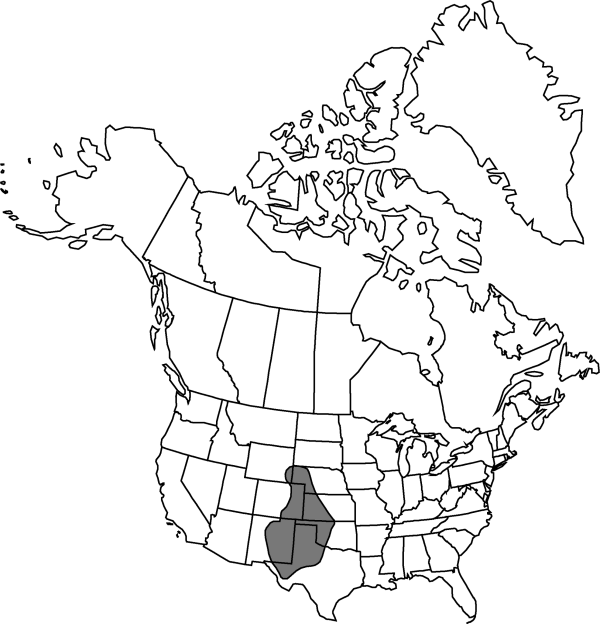Opuntia tortispina
Proc. Amer. Acad. Arts 3: 293. 1856.
Shrubs, low, to 0.4 m, creeping from clumps, sometimes from thickened rootstocks. Stem segments not easily detached, pale green to deep green, graying with age, wrinkled when stressed, flattened, broadly obovate to ovate, 6.5–15 × 4–10 cm, tuberculate, glossy, glabrous; areoles 6–9 per diagonal row across midstem segment, oval, obovate, or subcircular, 2.5–5 × 1.5–4 mm; wool tan, aging brown. Spines 1–9 on most areoles to only on distal 1/2 of stem segment, white to gray with pale-brown tips and bases, sometimes brown throughout; central spines 1–3, all deflexed or 1–2 porrect or ascending, terete or flattened, occasionally spirally twisted, 25–70 mm; small spines (2–) 3–6 (–8) strongly deflexed, usually slender, even bristlelike, 5–15 mm. Glochids forming a well developed adaxial tuft, yellow to brownish white, to 6 mm. Flowers: inner tepals yellow to gold, commonly darker to red near base, broadly spatulate, 30–40 mm, apiculate; filaments usually pale-yellow; anthers yellow; style whitish to pale green; stigma lobes greenish. Fruits purple-red, oval to broadly ovate, subspheric or short ovoid, bases not narrowed, 30 × 20–25 mm, fleshy, base not narrowed, glabrous, spineless or nearly so; umbilicus deep; areoles 18–30. Seeds whitish to tan, irregularly shaped, flattened, 4–6 × 3–4 mm; girdle protruding 1–2 mm. 2n = 44, 66.
Phenology: Flowering spring–early summer (Apr–Jul).
Habitat: Grass-lands, pinyon-juniper-oak woodlands, sandy or shaley flats, rocky hills
Elevation: 1400-1800 m
Distribution

Colo., Kans., Nebr., N.Mex., Okla., Tex., Wyo.
Discussion
Opuntia tortispina is apparently of hybrid origin. It has intermediate character states from its putative parents, O. macrorhiza (fleshy and spineless fruits) and O. polyacantha (areoles with basal deflexed spines and barrel-shaped fruits). The spirally twisted spines, which the specific epithet implies, are not at all characteristic for this species. When O. tortispina and O. cymochila are considered conspecific, the former has priority, as first selected by N. L. Britton and J. N. Rose (1919–1923, vol. 1).
One favored hypothesis as to the origins is that the O. humifusa-O. macrorhiza-O. pottsii complex spread across the United States from the east coast to Arizona. Opuntia polyacantha originated in north-central Mexico and spread northward. Tetraploid O. macrorhiza came into contact with the east flank of O. polyacantha and hybridized (probably repeatedly, even at present), producing the highly variable taxon referred to here as O. tortispina, which then spread eastward onto the plains. Opuntia tortispina has hexaploid members, presumably from unions of reduced and unreduced gametes. Those hexaploids apparently hybridize with hexaploid O. phaeacantha and add further to variation of O. tortispina. Many of these variations have been formally named or since treated as synonyms of O. macrorhiza.
Selected References
None.